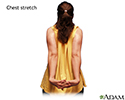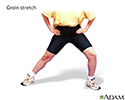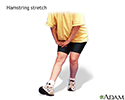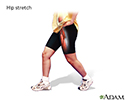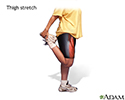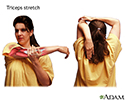Muscle cramps
Cramps - muscle
Muscle cramps are when a muscle gets tight (contracts) without you trying to tighten it, and it does not relax. Cramps may involve all or part of one or more muscles.
The most commonly involved muscle groups are:
- Back of the lower leg/calf
- Back of the thigh (hamstrings)
- Front of the thigh (quadriceps)
Cramps in the feet, hands, arms, abdomen, and along the rib cage are also very common.
Muscle cramps are common and may be stopped by stretching the muscle. The cramping muscle may feel hard or bulging.
Considerations
Muscle cramps are different than muscle twitches , which are covered in a separate article.
Muscle twitches
Muscle twitches are fine movements of a small area of muscle.

Causes
Muscle cramps are common and often occur when a muscle is overused or injured. Working out when you have not had enough fluids (dehydration) or when you have low levels of minerals such as potassium or calcium can also make you more likely to have a muscle spasm.
Muscle cramps can occur while you play tennis or golf, bowl, swim, or do any other exercise.
They can also be triggered by:
-
Alcoholism
Alcoholism
Alcohol use disorder is when your drinking causes serious problems in your life, yet you keep drinking. You may also need more and more alcohol to f...
 ImageRead Article Now Book Mark Article
ImageRead Article Now Book Mark Article -
Hypothyroidism
(underactive thyroid)
Hypothyroidism
Hypothyroidism is a condition in which the thyroid gland does not make enough thyroid hormone. This condition is often called underactive thyroid....
 ImageRead Article Now Book Mark Article
ImageRead Article Now Book Mark Article -
Kidney failure
Kidney failure
Acute kidney failure is the rapid (less than 2 days) loss of your kidneys' ability to remove waste and help balance fluids and electrolytes in your b...
 ImageRead Article Now Book Mark Article
ImageRead Article Now Book Mark Article - Medicines
- Menstruation
- Pregnancy
Home Care
If you have a muscle cramp, stop your activity and try stretching and massaging the muscle.
Heat will relax the muscle when the spasm begins, but ice may be helpful when the pain has improved.
If the muscle is still sore, nonsteroidal anti-inflammatory medicines can help with pain. If the muscle cramps are severe, your health care provider can prescribe other medicines.
The most common cause of muscle cramps during sports activity is not getting enough fluids. Often, drinking water will ease the cramping. However, water alone does not always help. Salt tablets or sports drinks, which also replenish lost minerals, can be helpful.
Other tips for relieving muscle cramps:
- Change your workouts so that you are exercising within your ability.
- Drink plenty of fluids while exercising and increase your potassium intake (orange juice and bananas are great sources of potassium).
- Stretch to improve flexibility.
When to Contact a Medical Professional
Call your provider if your muscle cramps:
- Are severe
- Do not go away with simple stretching
- Keep coming back
- Last a long time
What to Expect at Your Office Visit
Your provider will examine you and ask questions about your symptoms and medical history, such as:
- When did the spasms first begin?
- How long do they last?
- How often do you experience muscle spasms?
- What muscles are affected?
- Is the cramp always in the same location?
- Are you pregnant?
-
Have you been vomiting, had
diarrhea
,
excessive sweating
,
excessive urine volume
, or any other possible cause of dehydration?
Excessive sweating
Sweating is the release of liquid from the body's sweat glands. This liquid contains salt. This process is also called perspiration. Sweating helps...
 ImageRead Article Now Book Mark Article
ImageRead Article Now Book Mark ArticleExcessive urine volume
Excessive amount of urination means that your body makes larger than normal amounts of urine each day.
 ImageRead Article Now Book Mark Article
ImageRead Article Now Book Mark Article - What medicines do you take?
- Have you been exercising heavily?
- Have you been drinking alcohol heavily?
Blood tests may be done to check for the following:
- Calcium, potassium, or magnesium metabolism
- Kidney function
- Thyroid function
Pain medicines may be prescribed.
References
Grove AJ, Gómez J. Environmental illness. In: Miller MD, Thompson SR, eds . DeLee and Drez's Orthopaedic Sports Medicine . 4th ed. Philadelphia, PA: Elsevier Saunders; 2015:chap 25.
Wang LH, Lopate G, Pestronk A. Muscle pain and cramps. In: Daroff RB, Jankovic J, Mazziotta JC, Pomeroy SL, eds. Bradley's Neurology in Clinical Practice . 7th ed. Philadelphia, PA: Elsevier; 2016:chap 28.
-
Chest stretch - illustration
Clasp your hands behind your back with your palms facing up. Pull your hands down and press your shoulder blades together. Your chest should stick out. Hold for 10-20 seconds. You should feel the stretch in your upper arms and chest.
Chest stretch
illustration
-
Groin stretch - illustration
Stand with your legs wide apart. Shift your weight to one side, bending your knee somewhat. Do not let your knee bend beyond your ankle; in other words, you should be able to look down and still see your toes. You should feel the stretch in your opposite leg, which remains extended. Both of your feet stay flat on the ground facing forward. Hold for 10-20 seconds, then lean to the other side.
Groin stretch
illustration
-
Hamstring stretch - illustration
Extend one leg in front of you with the foot flexed. Bend your other knee and lean back slightly. Your pelvis should be tilted forward. Keep your upper body upright as you hold the stretch for 10-20 seconds, then switch sides. You should feel the stretch up the back of your extended leg (all the way up your calf and thigh). NOTE: Your supporting leg may get tired, as you have to balance your weight on it. NOTE:
Hamstring stretch
illustration
-
Hip stretch - illustration
Stand with one foot in front of you and your weight equally distributed between them. Bend both knees and lift your back heel off the ground. Bring your pelvis forward so your back is flat. (You can lean against a wall or column for balance.) Hold for 10-20 seconds, then repeat on other side. You should feel the stretch in the front of the hip and into your abdomen.
Hip stretch
illustration
-
Thigh stretch - illustration
Hold on to something for balance. Standing on one leg, grasp the foot of the other leg. Keep your knee pointing down. Pull up with light pressure. You do NOT need to pull up all the way to your buttocks. If it feels uncomfortable or painful, you are putting too much strain on the knee joint. Hold your foot behind you for 10-20 seconds, then switch sides. You should feel the stretch in the front of the thigh.
Thigh stretch
illustration
-
Triceps stretch - illustration
Bring one of your elbows across your body, towards the opposite shoulder. Use your other hand to bring your elbow closer to your shoulder. Hold for 10 to 20 seconds, then switch sides. Alternate method: raise your arm over your head and bend your elbow all the way so your hand is behind your neck. Use your other arm to stabilize your elbow. Hold for 10 to 20 seconds, then switch sides. You should feel either of these stretches in the back of your arm.
Triceps stretch
illustration
-
Chest stretch - illustration
Clasp your hands behind your back with your palms facing up. Pull your hands down and press your shoulder blades together. Your chest should stick out. Hold for 10-20 seconds. You should feel the stretch in your upper arms and chest.
Chest stretch
illustration
-
Groin stretch - illustration
Stand with your legs wide apart. Shift your weight to one side, bending your knee somewhat. Do not let your knee bend beyond your ankle; in other words, you should be able to look down and still see your toes. You should feel the stretch in your opposite leg, which remains extended. Both of your feet stay flat on the ground facing forward. Hold for 10-20 seconds, then lean to the other side.
Groin stretch
illustration
-
Hamstring stretch - illustration
Extend one leg in front of you with the foot flexed. Bend your other knee and lean back slightly. Your pelvis should be tilted forward. Keep your upper body upright as you hold the stretch for 10-20 seconds, then switch sides. You should feel the stretch up the back of your extended leg (all the way up your calf and thigh). NOTE: Your supporting leg may get tired, as you have to balance your weight on it. NOTE:
Hamstring stretch
illustration
-
Hip stretch - illustration
Stand with one foot in front of you and your weight equally distributed between them. Bend both knees and lift your back heel off the ground. Bring your pelvis forward so your back is flat. (You can lean against a wall or column for balance.) Hold for 10-20 seconds, then repeat on other side. You should feel the stretch in the front of the hip and into your abdomen.
Hip stretch
illustration
-
Thigh stretch - illustration
Hold on to something for balance. Standing on one leg, grasp the foot of the other leg. Keep your knee pointing down. Pull up with light pressure. You do NOT need to pull up all the way to your buttocks. If it feels uncomfortable or painful, you are putting too much strain on the knee joint. Hold your foot behind you for 10-20 seconds, then switch sides. You should feel the stretch in the front of the thigh.
Thigh stretch
illustration
-
Triceps stretch - illustration
Bring one of your elbows across your body, towards the opposite shoulder. Use your other hand to bring your elbow closer to your shoulder. Hold for 10 to 20 seconds, then switch sides. Alternate method: raise your arm over your head and bend your elbow all the way so your hand is behind your neck. Use your other arm to stabilize your elbow. Hold for 10 to 20 seconds, then switch sides. You should feel either of these stretches in the back of your arm.
Triceps stretch
illustration
Review Date: 7/13/2016
Reviewed By: Linda J. Vorvick, MD, Medical Director and Director of Didactic Curriculum, MEDEX Northwest Division of Physician Assistant Studies, Department of Family Medicine, UW Medicine, School of Medicine, University of Washington, Seattle, WA. Also reviewed by David Zieve, MD, MHA, Isla Ogilvie, PhD, and the A.D.A.M. Editorial team.


